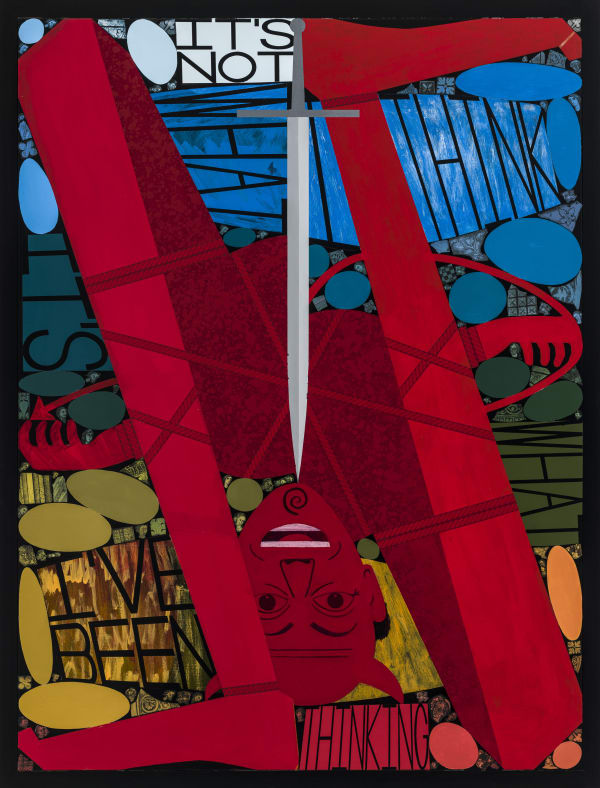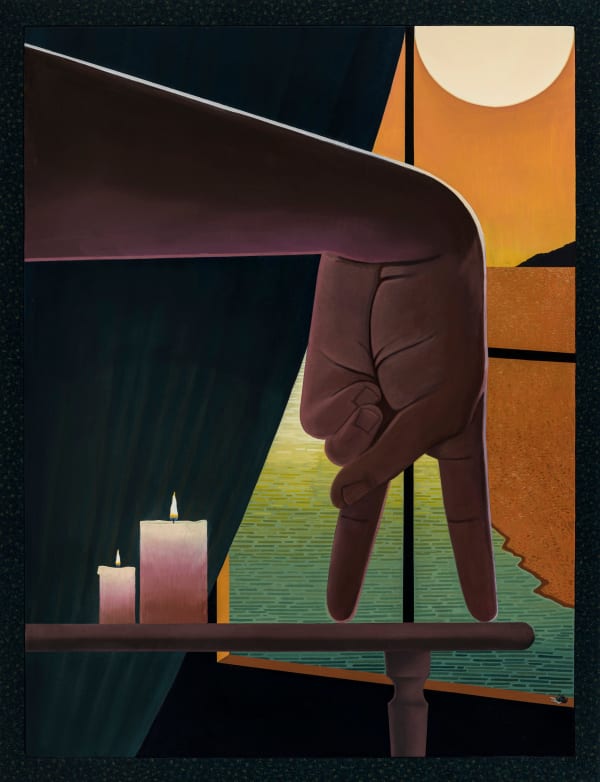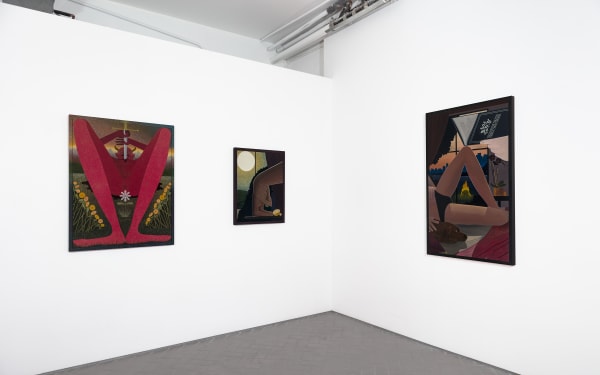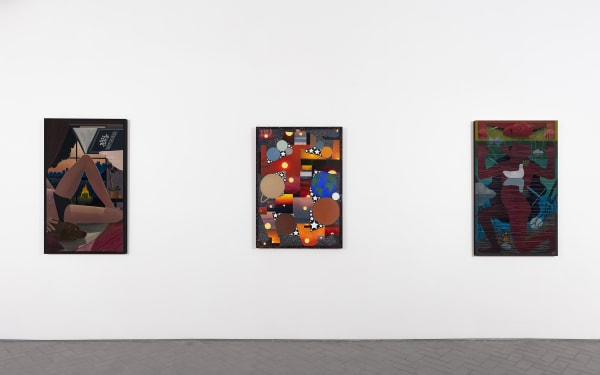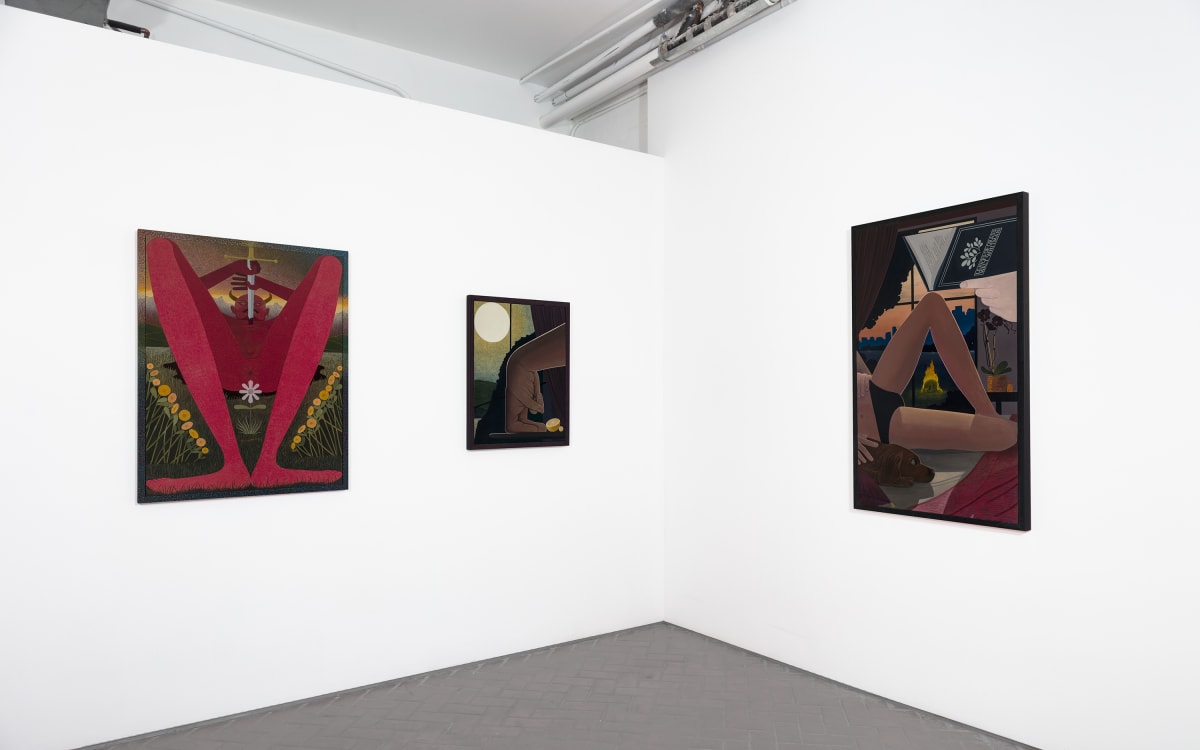Michael Stamm: “so super sorry sir!”
Why do people stay attached to conventional good life fantasies… when the evidence of their instability, fragility and dear cost abounds? Fantasy is the means by which people hoard idealizing theories and tableaux about how they and the world “add up to something.” What happens when those fantasies start to fray - depression, dissociation, pragmatism, cynicism, optimism, activism, or an incoherent mash?
- Lauren Berlant, Cruel Optimism
Shulamit Nazarian is pleased to present ”so super sorry sir!” , a series of new paintings by New York-based artist Michael Stamm. This will be the artist’s first solo exhibition with the gallery.
The paintings in “so super sorry sir!” revel in their idiosyncratic, contradictory attitude toward morality, sexuality, mental health, and contemporary cultural politics. They feature an unlikely cast of characters––ranging from the Devil to an anthropomorphic hand–– whose disparate senses of virtue and spirituality often clash with societal convention. At once clinging to life and hurtling toward annihilation, the artist questions what self-actualization looks like in the face of an overly righteous and emotionally precarious world.
The Devil appears as a surrogate for various archetypes––a conspiratorial friend, a scorned enemy, or at times, the artist himself. He is at once a foe to be vanquished and a sly, picaresque hero, providing an infinite set of entry points for the viewer to project their own definitions of “right” and “wrong”. In the titular painting of the show, “so super sorry sir!”, the Devil takes the role of a hysterical martyr, at once offering his patriarchal tormentor a flower, while stabbing himself with a sword. The painting reimagines a memory of a forced apology extracted from the artist by a homophobic teacher. Instead of flatly submitting, the Devil flamboyantly and sibilantly disobeys. Deploying icons of the Virgin Mary interspersed with images of historical gay villains, the work indulges both the aggression of sarcastic defiance and the kinky masochism of self-flagellation. Throughout the exhibition, the Devil, ever at odds with his environment and always nude, exuberantly plays out the iconoclasm of being a queer person. This dissonant, ever changing position associated with queerness may deny an easily resolved identity or moral stance but, ironically, is exactly what allows for the possible reconciliation of conflicting desires.
Turbulent aspects of the artist's own life inspire literal forms in the paintings ECT and Ketamine, two types of treatments for severe mood disorders. Here, the body is abstracted into outlines and shapes, reduced merely to a structure or vessel to be filled, effected and redeemed by external forces. In ECT (short for electroconvulsive therapy), fractured images of sunrises and sunsets suggest the ecstasy of returning from darkness, an ineffable capacity for pleasure that simultaneously evokes a specter of pain. In contrast, paintings such as Submission and Defiance use the body to evoke a quieter state of contemplation. Hands are anthropomorphized into the body itself, recalling intimate moments where we find ourselves on our knees such as in prayer or surrender, or standing in opposition.
Throughout Stamm’s practice, text highlights the talkative self-awareness implicit in his paintings. Whether functioning as the headspace of the artist, of the subject, or an omniscient voice, the use of text animates a thought into an object. In Ketamine, a K-pop music video the artist watched during an infusion inspires words written along the frame which read “Fun! My heart melts! Fun! Sweat Drips Down! Fun! Feels Dizzy! What’s wrong with me?”. Circling the figure like a lasso, as would a song maniacally stuck in our head, the text reminds us how obsessively and to what length we will go on our quest to induce a feeling of happiness.
In the painting April 14th, 2018, the literal representation of Walt Whitman’s text Leaves of Grass, connoting sensual praise of the human condition, contrasts the painting’s depiction of the death of well-known LGBTQ rights lawyer David Buckel*. Here, two men luxuriate in a post-coital glow while reading poetry to one another, their bourgeois interior punctuated by a lap dog, orchids and a bottle of poppers. Through the window and the tangle of body parts is the central focus of the painting: a man participating in self immolation as a final act of social and political protest. The friction of the two scenes questions what acts of radical opposition lay on the margins of queer intimacy and history—what hardness may, tragically, make queer intimacy possible. This painting, like many others in the show, attempts to complicate what acts we see as good, what feelings are worth celebrating, and what characters we ought to commemorate.
Together, the paintings in “so super sorry sir!” attempt the relatable quest of searching for peace and clarity by reconciling conflicting dimensions of our identity and autobiography. Facetious ‘sorry’s’ are counterbalanced by self-reflexive indictments of white gay men’s excesses. A desire to conform and be perceived as “good” caves to a desire to stand up to an authority figure for having misbehaved, or for being gay, or for failing to project or even experience happiness. Each work is part of a larger ambivalent prayer and perhaps, in the end, such a fraught and uncertain prayer is the only kind that exists.
*David Stroh Buckel (June 13, 1957 – April 14, 2018) was an American LGBT rights lawyer and an environmental activist. Senior counsel and marriage project director at Lambda Legal, he represented clients in many major LGBTQ rights related cases and was considered one of the architects of the freedom to marry and marriage equality movement”. At the time of his death, Buckel had become heavily involved in urban composting efforts. On April 14th, 2018, before dawn, he self-immolated in Prospect Park to protest the overuse of fossil fuels.
Michael Stamm was raised in Evanston, Illinois. He received his BA from Wesleyan University and an MA in English Literature from Columbia University before earning an MFA from New York University in 2016.
The artist's work has been the subject of solo exhibitions in New York at DC Moore Gallery and Thierry Goldberg, and has been included in several group exhibitions, including shows at Deli Gallery, New York; Jack Hanley Gallery, New York; Taymour Grahne Projects, London; Galerie Tobias Naehring, Leipzig, and Shulamit Nazarian, Los Angeles.
Residencies include the Skowhegan School of Painting & Sculpture (2016) the Vermont Studio Center (2016), for which he was awarded the John Imber Painting Fellowship, Yaddo (2016), the Mountain School of Arts, Los Angeles (2017) and the MacDowell Colony (2018). Stamm received the New York Foundation for the Arts annual NYSCA/NYFA Artist Fellowship in 2018.
-
 Michael StammGay Dead Satan, 2020Oil and acrylic on canvas wrapped panel with artist’s frame42 x 32 inches
Michael StammGay Dead Satan, 2020Oil and acrylic on canvas wrapped panel with artist’s frame42 x 32 inches -
 Michael Stamm, Inner Smile, 2020
Michael Stamm, Inner Smile, 2020 -
 Michael Stamm, April 14, 2018 (RIP David Buckel), 2020
Michael Stamm, April 14, 2018 (RIP David Buckel), 2020 -
 Michael Stamm, Devil's Dodge, 2020
Michael Stamm, Devil's Dodge, 2020 -
 Michael StammECT, 2020Oil and acrylic on canvas wrapped panel with artist’s frame45 x 32 inches
Michael StammECT, 2020Oil and acrylic on canvas wrapped panel with artist’s frame45 x 32 inches -
 Michael Stamm, Ketamine, 2020
Michael Stamm, Ketamine, 2020 -
 Michael StammNarcissus, 2020Oil and acrylic on canvas wrapped panel with artist’s frame50 x 30 inches
Michael StammNarcissus, 2020Oil and acrylic on canvas wrapped panel with artist’s frame50 x 30 inches -
 Michael StammSubmission, 2020Oil, acrylic and oil stick on canvas with artist’s frame30 x 23 inches
Michael StammSubmission, 2020Oil, acrylic and oil stick on canvas with artist’s frame30 x 23 inches -
 Michael StammDefiance, 2020Oil, acrylic and oil stick on canvas wrapped panel with artists frame30 x 23 inches
Michael StammDefiance, 2020Oil, acrylic and oil stick on canvas wrapped panel with artists frame30 x 23 inches -
 Michael Stamm“so super sorry sir!”, 2020Acrylic, marble dust, photocollage on canvas wrapped panels with wooden frame40 x 30 inches
Michael Stamm“so super sorry sir!”, 2020Acrylic, marble dust, photocollage on canvas wrapped panels with wooden frame40 x 30 inches
-
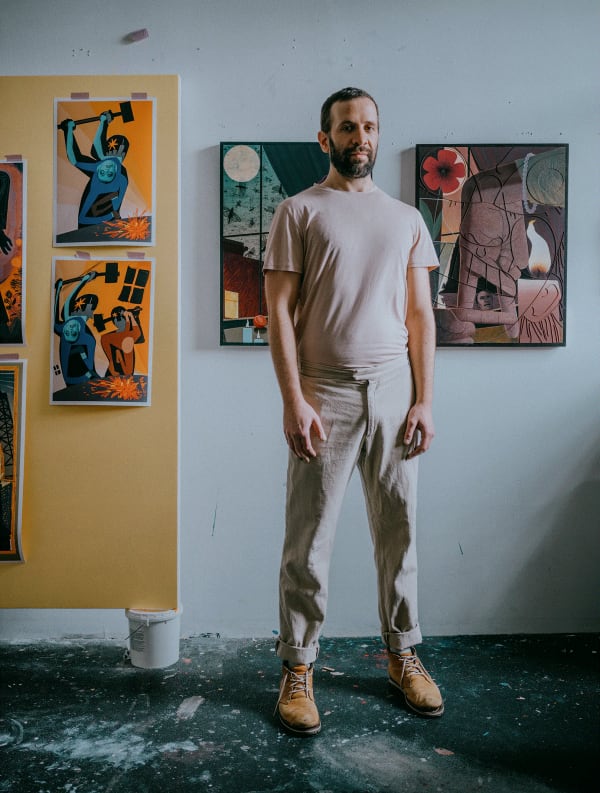
W Magazine: Changing the Perspective featuring Michael Stamm
Arthur Lubow, W Magazine, November 30, 2021 -
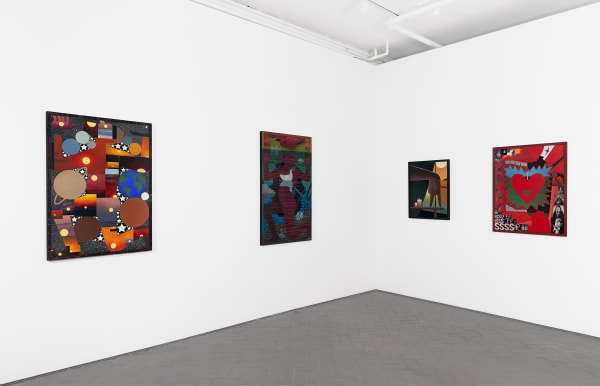
Art and Cake: Cammie Staros and Michael Stamm at Shulamit Nazarian
Sydney Walters, Art and Cake, March 16, 2021 -

super!: conversation with Michael Stamm
Olivia Toups and Jack Coleman, super!, February 21, 2021




